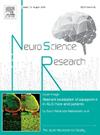The neurobiology of ticklishness
IF 2.3
4区 医学
Q3 NEUROSCIENCES
引用次数: 0
Abstract
Ticklishness is an idiosyncratic form of touch observed in multiple animal species, including humans. Although commonly regarded as trivial, it involves complex neurobiological mechanisms and diverse behavioral phenomena observed across species. Two distinct forms exist: knismesis, a mild tingling sensation elicited by gentle touch, and gargalesis, an intense sensation associated with involuntary laughter. Advocating the importance of clearly distinguishing these two types of ticklishness, this review synthesizes current knowledge on their neuronal underpinnings. Topics include somatosensory processing, self-tickling and sensory attenuation, emotional modulation, sociosexual dimensions, and evolutionary perspectives, among others. Special attention is given to the ambivalent nature of gargalesis, challenging conventional single-dimensional models of emotional valence. Ultimately, studying ticklishness provides a valuable opportunity to investigate playful emotional experiences from a naturalistic perspective, addressing fundamental yet underrepresented questions in contemporary neuroscience. Far from trivial, ticklishness thus provides valuable insights into the neural mechanisms underlying complex, context-dependent emotional and social experiences.
挠痒的神经生物学。
挠痒是在包括人类在内的多种动物中观察到的一种特殊的触摸形式。虽然通常被认为是微不足道的,但它涉及复杂的神经生物学机制和跨物种观察到的多种行为现象。有两种不同的形式:一种是轻触引起的轻微刺痛感,另一种是轻触引起的强烈的笑声。提倡明确区分这两种类型的挠痒的重要性,这篇综述综合了目前关于它们的神经元基础的知识。主题包括体感处理、自挠和感觉衰减、情绪调节、社会性别维度和进化观点等。特别注意的是gargalesis的矛盾性质,挑战传统的情感价的单维模型。最终,研究挠痒提供了一个宝贵的机会,从自然主义的角度来研究好玩的情感体验,解决当代神经科学中基本但未被充分代表的问题。因此,挠痒远非微不足道,它为研究复杂的、情境依赖的情感和社会体验背后的神经机制提供了有价值的见解。
本文章由计算机程序翻译,如有差异,请以英文原文为准。
求助全文
约1分钟内获得全文
求助全文
来源期刊

Neuroscience Research
医学-神经科学
CiteScore
5.60
自引率
3.40%
发文量
136
审稿时长
28 days
期刊介绍:
The international journal publishing original full-length research articles, short communications, technical notes, and reviews on all aspects of neuroscience
Neuroscience Research is an international journal for high quality articles in all branches of neuroscience, from the molecular to the behavioral levels. The journal is published in collaboration with the Japan Neuroscience Society and is open to all contributors in the world.
 求助内容:
求助内容: 应助结果提醒方式:
应助结果提醒方式:


